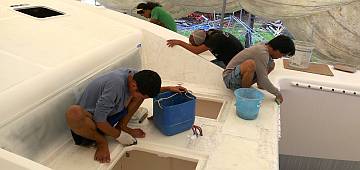
Wet-sanding the foredeck with ever finer grits of paper
101 Spray Forebeam
Summary: This week was our third Vegetarian Festival, which is not at all what it sounds like. But the main boat work was sanding and polishing the deck and the sugar‑scoops. Other team accomplishments include:
|
 Wet-sanding the foredeck with ever finer grits of paper |
Monday, October 7: Celebrations
A cool, cloudy day with tons of rain seen approaching on the radar, but very few drops falling on
the boatyard.
Jon took advantage of the rain‑break to scooter half an hour north to a big electrical shop. We are coming to the conclusion that sometime during Golf's reign of theft on the boat all the interior lights went missing. We can't find our 8 reading lights and 26 flush‑mounted overhead lights. With Jon working on the wiring it was natural that we would start thinking about the lights again. We did manage to find the little LED disks that replace the G4 halogen bulbs, but we have nothing to put them in. Local lighting shops have many small overhead light fixtures, but very few for this G4 bulb, and none with the kind of construction that will stand up to our salty atmosphere. B‑O‑A‑T. Break Out Another Thousand. This time for lights, if we don't find some clever way to make a local product work.
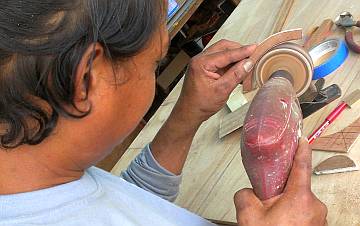 Houa shaping a template for the large-radius salon teak |
Houa finished up the teak trim in the cabins, and we asked him to stop short of actually sticking the strips in place. Before they can be given a final OK we have to get the underlying rubber pads made that hold the floor boards. But we've decided this can all wait. A bigger priority is to finish the woodwork in the salon so that Baw can send some of his team in there to finish the sanding and varnishing.
We have long known that the teak veneer on the salon seats have a few places where it broke off, and until recently we thought we were going to need Houa to cut out and replace the veneer. But to attack the problem in another way, Houa suggested putting a piece of solid teak facing on the vertical wall around the seat tops. If he makes it just 1½" (4cm) high, it will cover the blemishes and protect the delicate top of veneer. This piece will run all the way around the 8 seats and be flush with the seat top itself, thus stopping further veneer damage. He jumped right in by making templates for the 4 big external curves, and the 4 smaller internal curves. Checking our teak supply in the woodshop we may have all the necessary wood already.
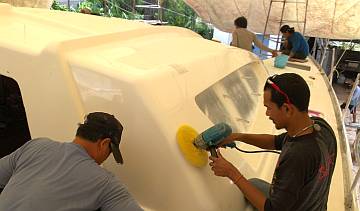 Pla and Baw at a favorite activity - polishing nice gelcoat |
Sue tried her hand at playing "handy‑lady" and ran into 2 snags right away so waited for Jon's return. She did get the aft cabin drawers in place, but when she mounted the latches with their push buttons, the latches stopped working. They worked un‑mounted. Didn't work mounted. Jon discovered the culprit -- too much paint or varnish inside the push button rim, so it didn't move through the front of the drawer correctly. Sue also tried mounting the bunk steps. They are mounted with long piano hinges, and Jon got them all started last week, so Sue tried to finish the mounting. Same sort of problem: they drop into place nicely un‑mounted, but not when screwed in. Grrrr. Same sort of problem -- too much varnish in the wrong places so they don't settle correctly. This will take some careful sanding and cutting back.
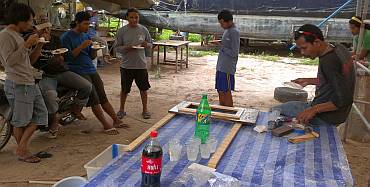 Yando, Heru, Akoosh, Lek, Houa, Ben, Baw, & Chambron |
Sue's fun chore of the day was 2 trips south of the Chalong round‑about to the Swensen's Ice Cream shop. It's Baw's 26th birthday, and his turn for an ice cream cake. Sue got it ordered and paid for in one trip, then picked it up (along with sodas, ice, spoons and cups) in a second trip. Everyone took a break at 2:30 while we sang and stuffed ourselves on Neapolitan ice cream cake with chocolate swirls and iced real strawberries. Yum.
Baw deserved the cake, not only for his birthday, but for his great leadership in getting the deck polished so quickly. Today the team finished with the 2000 grit sandpaper (WOOT!) and Baw set up the electrical polisher and a mixture of polishing compounds (3M and Solar, in a 1:2 mix). Working with Pla, they made their way across the whole of the cockpit helm station area and forward along the starboard side of the deck. Meanwhile, all 6 other workers moved from the foredeck and bows back to the port sugar‑scoop to begin the full process of sanding once again, from 320 grit up through 2000. Really moving along!
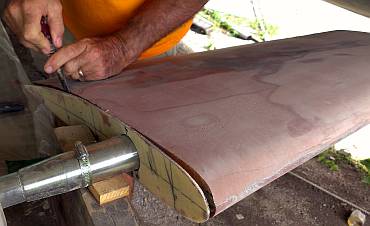 Prying off Neil's template for the new rudder shape |
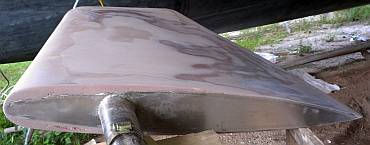 The pink filler shows how much the rudder's profile changed |
Jon worked on the rudders again today, removing the fiberglass template from the top of each rudder. These had been attached with a hot glue gun to the bare stainless steel, originally, but of course, with all the glassing and epoxy filling they ended up sort of stuck on there. We can't leave them, as we need to protect the top stainless surface, and anyway we have a very tight tolerance on that top surface, as the rudders come quite close to Ocelot's hull (as they're supposed to do).
Neil, our rudder designer, stopped by and ran his hands over the shapes, declaring them to be quite good. Jon teased him about his ability to stay calm and stop himself from saying "Throw the silly things out and start over!" Neil just laughed. But Sue had a ride towards home with Neil, and he told her once again that he likes the shapes, which is nice to hear as they certainly were NOT nice when we started reworking them. They now have a much fuller shape than the base stainless steel that was welded up. Neil confirmed that we want to extend the trailing edge of fiberglass about ½" (12mm) beyond the sharp edge of filler, clamping it just past the filler to make sure the fiberglass is well bonded to itself.
The Vegetarian Festival started this weekend and runs all week. For those who think it's as ho‑hum as the name implies, it's anything but. People parade through the streets with all manner of implements pushed through their cheeks, others climb 60' (20m) ladders of razor‑blade rungs with only bare feet, while others walk (well, run) across 20' (6m) long beds of glowing coals. A tiny procession which only had about a dozen "Ma‑Song" (literally, sacred horse - the folks who poke stuff through their cheeks) came down towards the boatyard.
 2 Ma-Song at a station to take away the family's bad demons |
We are working towards a pre‑Xmas (19 December?) splash date, but it's going to be difficult. Not only do whole weeks of rain slow things down, but this unpredictable weather makes it hard to move along on a project (like painting the mast) which needs several days of good weather in a row. Then there's the whole mast and rigging to assemble. And there are still a gazillion details to work out, and hundreds of bolts and screws to attach that will mount our dozens of deck fittings. Let's hope we don't have too many more bad surprises like the loss of our lights. Okay. Take a breath. Optimism feels better than pessimism.
Tuesday, October 8:
A massive squall at 8:15am means half the workers arrived soaked! Thank goodness for the warm
weather. A semi‑sunny day means we got good things done!
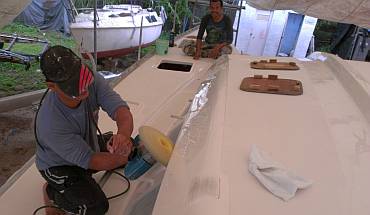 Baw (on the bow) "training" Pla to use the polisher |
Unfortunately Jon was under the weather with an on‑coming cold, so he stayed home and Sue held the fort. The first order of business was to try and sort out with Baw just what Lek was doing with the teak doors and floors that he seems to be sanding so much. Sue had a brain‑fade and went along with the idea that Lek was to sand the floors with 1500 and 2000 then polish the polyurethane. It wasn't until lunchtime when she talked to Jon that we realized we don't want polished floorboards in the galley or heads. They'll quickly get marked up and they'll be slippery! So after lunch, even though Baw was gone, Sue managed to communicate to Lek to stop sanding the boards. Sue moved the boards to the store room, with notes on them as to their varnish status. Gets pretty confusing at times!
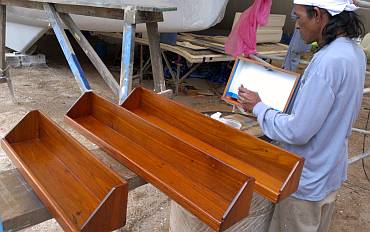 Lek finished up several bits of varnish work |
Lek, having been pulled off the floorboard sanding was free for other work, so Sue introduced him to the 3 bookshelves that needed a final varnish repair. The sun was peeking out and the humidity was under 74%, so he sanded the small areas and brushed on satin varnish. This should mean these final bookshelves can be returned to the store room tomorrow to await mounting once the headliners are up. From the varnish project Lek moved up to the gelcoat job on the deck.
The gelcoat is looking amazing! Baw and Pla spent time in the morning with fine cutting/polishing compounds going over all the non‑nonskid areas. Obviously Baw was sort of teaching Pla the techniques, because once Baw left for his afternoon medical appointment, Pla spent the rest of the day going around the deck with the big polisher. Again. Baw is doing it 3 times, as he claims he can see the sandpaper scratch marks still, and that it will be more obvious once the boat is out from under the tent.
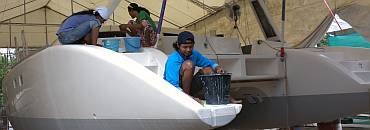 The Indonesians sanded the new port sugar-scoop gelcoat |
In the morning Ben worked alone on starboard sugar‑scoop, marking and then wet sanding with 320 grit. Meanwhile, we had our Indonesians, Akoosh, Heru and Chambron on port sugar‑scoop all day. There's a lot of area to be sanded, and some of it is quite tricky, like down in the groove for the ladder and around the ladder hinge areas. They all seem to have abandoned the white board marker approach and are using pencil in big swirly patterns to mark where they need to sand, and let them see where they have already sanded.
Sue spent the day cleaning and organizing things. The goal was to get all our project stuff and tools out of the salon so that A) Houa can work on the salon seats and B) the guys can start the sanding and varnishing project in there. Where to put it all? The port aft cabin was the first choice, but Sue discovered that the water from the deck sanding had gotten the new bunk wood wet, and that needs to dry ASAP so that it can be protective epoxied. (This is where Houa rebuilt the bunk, which had been damaged when the whale hit us off Mozambique years ago.)
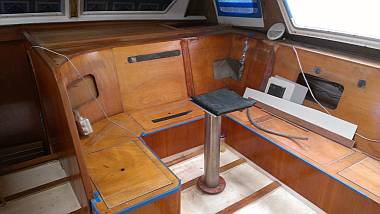 Everything was moved out of the salon to prepare it for varnishing |
So, with port aft drying out, Sue attacked starboard aft cabin and also found that water had come in the hatch opening (despite future board and silicone sealant), but at least the bunk there is varnished, so no harm done. Once that cabin was all cleaned out (it was covered in plastic masking from the varnish spray and dust from the earlier projects) Sue could begin moving things in from the salon. It's both kind of fun and kind of frustrating to organize all this stuff. There is SO much stuff on a boat! And this is only a small part of it.
With the salon all cleared out and cleaned out, Houa could move around in there to work on making the front teak strip for the seats. He had used the morning to draw, cut, shape and sand the first 4 corner pieces: 2 outside big curves and 2 smaller inside curves. Checking them out in situ, he was able to assess his work so far. He must have been happy, because his next step was to find long teak strips to use for the straight pieces between the curves. Looks like we may have enough teak to do the job, but he'll have to scarf 2 pieces together to make the long piece on the forward side of the seats.
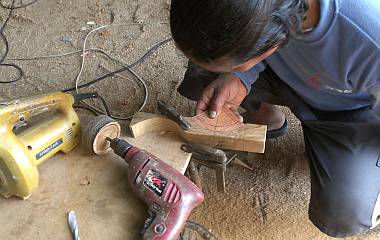 Houa building some large radius thick corner blocks |
Bad news of the day is that, in cleaning the salon up, Sue found more previously wet, and now de‑laminated teak veneer on the starboard big shelf, up near the port light. This is the twin place to the port problem area for which Houa make a whole new bit of shelving and veneer. Looks like we'll still have interior work for him to do.
Good news is that at clean‑up time we were able to move the last varnishing projects to the side, and get the bimini clear. Maybe tomorrow we can start the final sanding of the bimini edges so that it's ready for gelcoating. Well, once the rain stops!
Wednesday, October 9:
A Day Without Rain, but we weren't really prepared for it, so no epoxy or painting happened.
But it looks like it might stay clear for a couple of days, and we're now ready to glass the
rudders.
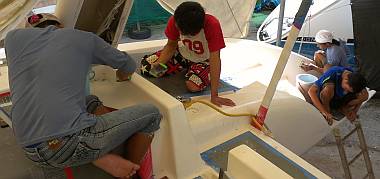 Lots of activity sanding the gelcoat on the starboard sugar-scoop |
It was another 5 Ring Circus Day on Ocelot with Sue playing Ring Master, once again. With many of the men arriving by 8am, we like to be there to greet them and get the day going. At first the men worked on sanding the gelcoat on the sugar‑scoops, as they were doing yesterday. But once Baw arrived it was time for some people shuffling. Given the nice weather, we decided that the salon teak needed some attention.
So Baw got Lek and Pla into sanding the bare teak on the side shelves of the salon. They had to be very careful to do it well, but not too well, as we don't want the veneer to disappear. They used acetone to clean the surfaces, then sanded with 220, then 320 grit sand paper. Dry, not wet. They worked not only on the side shelves, but up under the forward window as well. On starboard, Lek used paint remover to get rid of the remnant of varnish under the speaker. We found some delaminated veneer way forward (where it doesn't show), and decided to cut it away, and apply lots of epoxy to seal the wood. With a dry, hot day tomorrow, they should be able to get 1‑2 coats of clear West System epoxy brushed on as the first protective layers. These will be topped by polyurethane with UV inhibitors to protect the epoxy.
 Houa's corner pieces, cut from a single piece of teak |
Houa also was doing salon work. The trim he's building will go around the inside of the wooden seat (shown in the picture, above, left). He got 2 long pieces of teak scarfed and glued together in the morning. Making a scarf by hand is almost a work of magic, as you can't re‑adjust the angles of cutting or sanding without blowing the whole thing. Then he used the fat, newly laminated piece of teak from yesterday to cut the remaining 4 corners, 2 large and 2 smaller. All of this, without needing to interfere with the sanding in the salon, all day. He popped up to check the corner curves once. Oh, and we showed him the big area of delaminated veneer on starboard shelf and he went out after lunch to buy the 5mm solid teak that will cover that area.
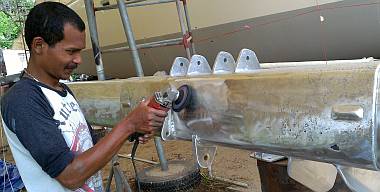 Baw using a grinder with a polishing disk on the forebeam |
Four men continued the sanding of the gelcoat on the 2 sugar‑scoops. Ben and Yando worked on starboard and had the harder job of still cutting with 320 grit. This side had only been worked on by 1 person so far, not a team like on port. On port, Chambron, Akoosh, and sometimes Heru moved up from 320‑600 grit and were almost finished by day's end.
Baw and Heru started out hand sanding the forebeam with 150 grit, but when they turned it over, they found it had never had the grinder attention it needed. So once again the boat yard near Ocelot was filled with the whirr and whine of the grinders on aluminum. Baw wasn't feeling well, so went home after hunch, and Heru continued with first the coarse and then the fine grinding wheels. The goal is to have the surface smooth enough to look good with paint, but rough enough to have the paint get a mechanical grip on the aluminum. No rain is forecast for the next couple days, so there's a chance we might spray primers on the forebeam by Saturday. Fingers crossed.
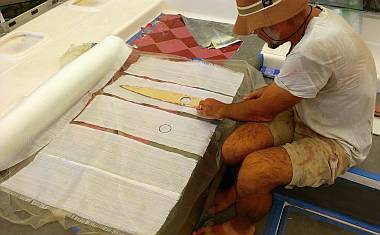 Jon cutting 200g fiberglass for the tops of the rudders |
Jon was feeling better, but still not 100%, so he came in late and got some quiet work done on the rudders. He cut out 200 weave fiberglass for the tops of the rudders, and he and Sue worked on the templates of wood that we'll clamp together at the trailing edge of the rudders once they are glassed. Jon also made modifications to the wooden table so that the rudders can turn more easily to be worked on, and wrapped their lower bearing surfaces in tape to protect them. If Baw had been there in the afternoon, they might have gotten the rudders glassed. But there's always tomorrow.
We had a disconcerting surprise when Houa crawled deep into his wooden storage box and pulled out a grubby, wet, moldy smelling roll of electrical cable. "I find this long time lying here and there. And I take and put in the box so no one take it. I forget I have it here." Yikes! It's our new (as of a year ago!) special cable for our wind instruments on the masthead. Very pricey stuff, bought right here in Phuket at a marine electrical shop for a small sack of gold. We weren't looking for it yet, but we would have been and had no idea where it was. Did we really just leave things lying around last year? Maybe so, as we thought we were going to be wiring the mast a year ago... Silly us. Sue's mini‑project for the day was to clean it up, recoil it, and stow it with our stuff.
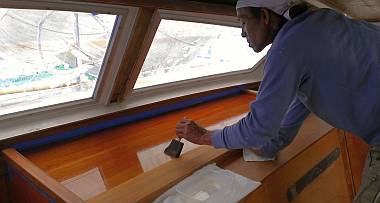 Lek brushing thinned epoxy on the big salon teak shelves |
Thursday, October 10:
Another Landmark Day on Ocelot. We have real rudders again! But we jump ahead...
Lots happened inside the salon today. Lek did a final acetone wipe‑down on the port salon shelf and the shelf under the front window, then got on several layers (wet‑on‑wet) of West System epoxy resin to seal the teak. It's looking great! Then he did a bit more old varnish removing on the starboard side shelf, got that all cleaned up and acetoned, then in the afternoon he got the first coats of epoxy resin on that side as well.
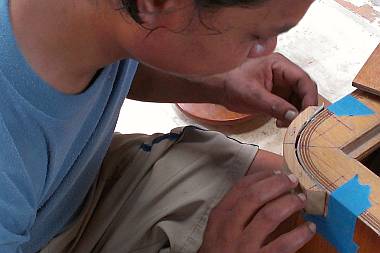 Houa epoxying a teak corner piece onto our salon seats |
Houa finalized the 4 big outside curves for the salon seat borders. At Jon's request he changed from a straight butt joint to a 45° scarf when transitioning from the straight to the curved pieces. This will make the joins stronger, so they will hopefully last longer. After lunch he sanded and cleaned the four corners and got the new teak pieces glued in place. He had them all numbered, 1‑4, because the 4 corners were not the same (of course!) Tomorrow he should be able to get the 4 inside, smaller corner pieces put in place, and maybe even some of the long straight teak boards between the corners.
Five men worked on the sugar‑scoop gelcoat all day. On port, Chambron and Akoosh continued with 600 grit sanding, and it was going pretty fast. Seems like the pencil marking takes the longest. Baw has honored the fact that we really don't like black spray paint as a marker, but the pencil is more time consuming (and less damaging). On starboard (and in the way of the ladder to the cockpit) we had Ben, Pla and Yando all day. They were finishing up the 320 grit, some of which was getting a second sanding. Baw blames the pencil for this second sanding, as it obviously can't "color" every square mm, so they miss some places. None of the men seem to have learned to sand by eye and feel. They know we worry about too much gelcoat being sanded off, but they worry about it looking good. Compromises are in order, but they've already sanded through the gelcoat in a few places, so Baw will have to do a repair shoot sometime.
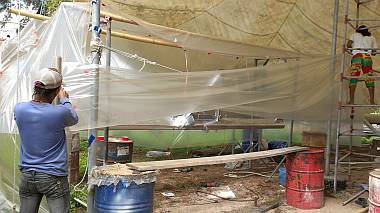 Heru and Chambron erecting another spray tent, for the forebeam |
More progress was made on the forebeam today. Baw and Heru used the grinders with the finer wheels in the morning to finish sanding the aluminum surface. Then together with Chambron they re‑erected the plastic tent around the hanging forebeam, completely sealing it in, with a taped off opening at one end. When Baw sprays primer and paint they will set up the extractor fan to move the air through.
Baw wanted to do an oxalic acid wash after the sanding, so we checked with Top, owner of our local chandlery, who sells the primer we'll be using, and he said it was OK, and up to us if we wanted to. Baw is worried about the small pit corrosion places on the bottom of the forebeam that will continue to corrode if not properly pacified with an acid wash. So we mixed up a recommended concentration of oxalic acid crystals and fresh drinking water (not the yard's tap water) and Baw and Heru brushed that on after lunch. The wash wetted out nicely on the sanded aluminum, but in a couple places it beaded up. It was a great indication of places that still needed more sanding. So Heru fired up the grinder again and got the last sanding done. Then he used more of the drinking water to fully rinse the forebeam.
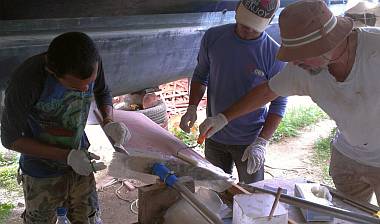 Laying the top pieces of glass on the epoxied steel |
If the tent stays intact tonight (and no rain, dust, birds or bugs get in) we should be able to get a recommended thin layer of OceanMaster primer sprayed on, followed in the afternoon by 1‑3 coats of International Interseal 670 as a primer under the polyurethane top coat. Can't wait! First of the spars to receive the "new treatment" and a real step forward after our disillusionment with Nyalic.
The big Landmark News of the day is the rudders. Sue and Jon spent an hour in the morning finalizing all the preparations for The Big Fiberglass Event. Sue finished wrapping the trailing edge battens/templates in shiny release tape, and carefully marking which way they are to be clamped. We gathered the gloves, pre‑cut fiberglass, fiberglass scissors, Epotek resin, phenolic filler, mixing containers, stirring sticks, rollers and roller handles, acetone, rags, 80 grit wet/dry sandpaper, and polyethylene plastic sheeting. At 11am we started work, with Baw and Heru pulled off other jobs.
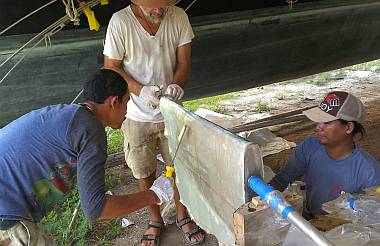 Baw, Jon and Heru wetting out another sheet of biaxial |
Jon mixed up the epoxy, and Baw and Heru gloved up, acetoned the exposed stainless steel top of a rudder, then hand‑sanded the resin into the steel until they had a gray slurry, showing that the sandpaper was cutting the top layer of oxide and mixing it with the stainless, thereby allowing a good chemical bond. Then Jon mixed a bit of filler into the resin so that they could paddle it into a few low crevices (in the earlier, hardened filler), before covering the rudder top with 2 layers of 200g cloth. We can't put more on the top, as we have very little clearance between the rudder and Ocelot's hull.
Once the top glass was carefully wetted out, they rolled resin on the sides of the rudder and draped on a large pre‑cut piece of biaxial glass. This had to be carefully pulled in just the right way to be sure to cover the entire rudder. Then Baw did his roller/fiberglass magic on the corners and got that rectangular piece of cloth shaped to fit the very un‑rectangular rudder. Lots of clever cutting with the scissors to fit the glass and wrap it around the edges. With both rollers going, the men were able to work both sides of the rudder at once, and work out all the air bubbles. Two more sheets of 400g biaxial were applied, then a (sacrificial) layer of 200g glass to cover it all.
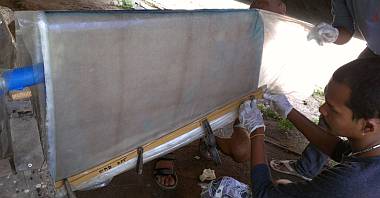 Clamping the trailing edge together to form a strong tail |
Each piece was left to dangle straight down at the trailing edge where the new rudder shape is a very sharp "V". Once all the glass was on we draped the rudder in a polyethylene sheet and worked the bubbles out from under that. Finally, we positioned the battens on each side of the glass just under the trailing edge of the rudder and clamped them tight with 7 clamps to squeeze the 2 sides (8 sheets) of fiberglass together. Once cured, we'll be able to cut that final tightly compressed edge to just the size we want.
We got one rudder finished just before lunch time, and the second one at about 2:30. Woot! Two real rudders, at last. Only 2.5 years after the old one broke and fell off north of Phuket! All they need now is a light sanding and a coat of primer before they can be installed, and we'll start to look like a boat again.
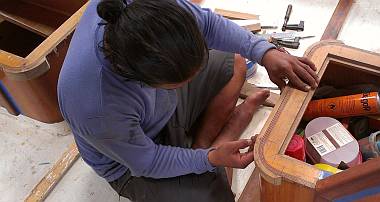 Houa fitting a 12x40mm teak strip between 2 corner pieces |
Friday, October 11:
Ay yai yai. What a day. Ups and downs. Rushes and slow downs.
Disappointments and success. And the week isn't even over yet. Warning, Sue rants a bit!
The men were in bright and early today (as we've requested) and all were on station and moving along. Up on the sugar‑scoops we had Chambron and Akoosh sanding the fine stuff like 800 grit before lunch and 1500 grit after lunch. On starboard we had Yando, Ben and Pla trying to catch up, and they ended the day with most of the steps finished with 800 grit. It's all beginning to look shiny!
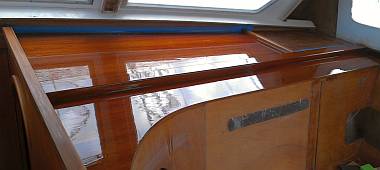 Lek's lovely epoxy work up on the big portside salon shelf |
Lek worked inside the salon, sanding yesterday's epoxy coatings, cleaning up, then applying a new coat to both port and starboard. He still can't work on the far shelf on starboard because we need Houa to do the veneer repair there. But we were happy to see Houa had taken time from the salon seat trim job to cut and plane the 5mm solid teak that will cover the old damaged veneer place. So maybe on Monday or so Lek will be able to get epoxy on that area as well.
Houa got more of the salon seats trimmed in solid teak. He scarfed the join edges of the straight pieces on the aft side seats and got them glued on. He got all the interior small corners glued in place, and began working on the tricky straight join on the aft‑most edge where his new teak has to meet with a diagonal strip. He definitely seems to be enjoying his work, which makes us happy as we know he does good work when he's happy.
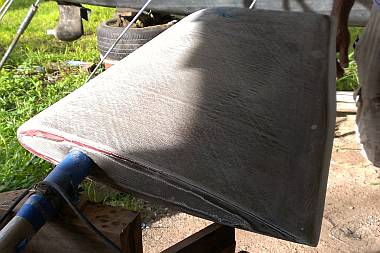 The rudders still need some work on their tops and trailing edges |
Jon played with the rudders much of the day. The bodies look great, but the tops of the rudders have air bubbles under the glass, so they'll have to be redone. A bother, but not a big job. A bit more difficult is that the trailing edge on the second rudder, where we clamped it, is noticeably kinked relative to the rest of the rudder. But Jon worked on that for several hours and it looks like he can make it work.
The big project of the day was to be the etch priming and then white priming of the forebeam. Baw chose to use his 1.3mm (small) nozzle gun. Not sure why, but we leave these things to him. The guys carefully mixed up one half-liter set of OceanMaster Etch Primer, and we were surprised to see (smell) that the "hardener" is actually isopropyl alcohol. The trouble started when Baw began to spray. No matter how he adjusted his gun, he was getting a splotchy result, not the smooth, fine mist that we expected. After half an hour we had a very strange‑looking forebeam: mottled light green, dark green and all covered in little strings of paint. So Sue scootered off to the apartment to look up the specs for the primer to be sure we were doing things right. Sure enough, there was no mention of using a thinner (we weren't using one). But the recommended "pot pressure" for "conventional spray" was 40‑60 psi, which was completely confusing. Only airless spray pressurizes the pot. With conventional spray, the pot is unpressurized and the paint is pulled to the nozzle of the gun by gravity or suction. So it seems that their spec‑sheet is at least somewhat whacked.
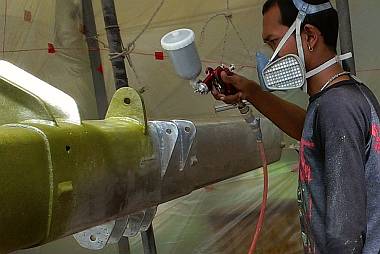 Baw, not at all happy with the first coat of etch primer |
But why the stringy look? Sue called the OceanMaster tech rep at the Singapore office, who was very interested in helping but he needed to see pictures and he needed some time. So we sent off an email with detailed shots, had lunch, and called him again. The response: did we prep correctly with sanding, wash and acetone? Yes, yes, and yes, but the problem wasn't the substrate of aluminum as the spraying result was the same against the plastic tent. The clock was ticking, and Sue was getting antsy. This stuff is supposed to go on fast and thin. Then within 3‑12 hours you need to get the next layer of (another) paint on top of the green etch primer. We had to get that second paint on this afternoon, or forfeit the day and sand things again tomorrow.
Singapore's response was that we needed to put on a second coat of primer. Right away, before the primer oxidized. He also said we had to aim for 12 microns of dry finish. Okay, just how the heck does one measure microns out here in a boat yard in Thailand? So we asked if the green should be opaque, and he said yes, and that obviously by our photos we didn't have enough product on the aluminum spar. No worry about having too much primer on there. But also no mention of the strings of primer that stuck up on top of the surface.
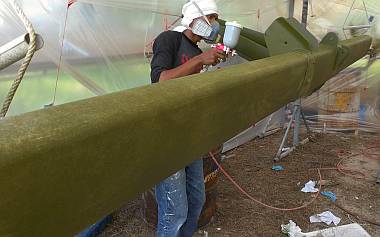 The second coat of etch primer seemed to go on a bit better |
Sue returned to the yard to find that Baw and Heru had gently sanded the new primer because whatever we did (short of sanding it all off) it had to be sanded. The little green strings of primer actually just wiped off the surface like green dust, so no way was any other paint going to stick! Frustration was mounting, and the clock alarm was buzzing loudly now. It was 2:30. There wasn't time to roll on a second coat and still get the next (white International) primer on today. If we just dropped the whole thing, we'd have to start fresh tomorrow with a sanding and wipe‑down, then a new spray (or brush/roller) and still meet the 2-12 hours re-coat requirement.
Sue at this point was cursing all paint and aluminum coating manufacturers (Nyalic and Oceanmaster being at the top of her list) for their incomplete instructions for use, trouble‑shooting help, and contradictory information (a Phuket chandlery's website has a different spec sheet for this OceanMaster etch primer). If there is a "highly recommended method of application" it would be nice to know that up front. If there are critical temperature and humidity requirements that is also good to know. It would also be good to know what the potential risks are for pushing those parameters. For example, Max Cor, an Awlgrip product which we are now seriously considering again, states right up front that if overcoat times are exceeded, one has to remove all the product and start over. If a product usually looks splotchy and stringy, that should be stated (sort of like a recipe where it says that the batter will be lumpy, but that's OK).
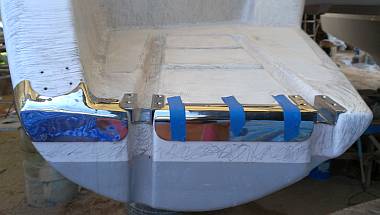 The new SS transom protectors, with the swim ladder hinges |
Decision time. "Up to you," said Baw, in typical deference to us (even though he knows much more about all this than we do). He then offered to spray the etch primer again and then stay late to finish the white primer today. Wow. A very nice offer. So we agreed and quickly geared up. We realized the men had sanded the green primer with bare hands and had touched the surface. So we tried first acetone (too strong) and then alcohol to gently clean the (now sanded) surface. Then Baw prepared his bigger 1.8mm gun (changing tactics, to maybe help the stringy problem) and Jon fired up the compressor. At 2:30 Baw, with white pirate bandana on his head and a Darth Vader breathing mask, did a mock "wai" (prayer gesture) to the forebeam. He did a test spray against the tent wall, and we saw the now‑familiar stringy green lines. But Oh Well. We had been told by OceanMaster Singapore to put on a second coat, and make it opaque, so that's what Baw set out to do, strings or not. Twenty minutes later we had a fully green forebeam and 2 forebeam brackets.
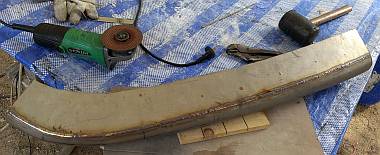 Newly welded up starboard bow protector |
We now had a 2‑hour wait before we could spray on the Interseal 670. Luckily, there was plenty to keep folks busy and entertained. First thing in the morning, the machinists from AME came by (unannounced) to final‑fit the stainless steel bow and stern protectors. They had one nicely polished bow protector, and the second one, not yet final‑welded, nor polished, and marked "port?". So, naturally, they started by trying to fit the polished one on starboard, but it didn't go. So they pounded on it with a rubber hammer, used wedges to try and open it up more, and hammered on it (and our bow) some more. The only thing that had changed since the last fitting was the addition of several layers of bottom epoxy and then primer. Finally someone twigged, and swapped the protectors, and Voila! They fit much better. Jon crossed out the "port?" and substituted STBD. (Who ever suggested that a catamaran was a symmetrical creation?)
After the bow fitting, there was some spot welding to do (right there in the yard). They also had lots of finagling to do to fit the stern/transom protectors. These needed some measuring and cutting because the stainless pieces come quite close to, but cannot overlap with, the swim ladder hinges and the side railings. Jon retrieved the railings and ladders from the storeroom and together the men got all the right angles and shapes figured out. Unfortunately, the AME guys forgot to bring the long inner sugar‑scoop protectors, so they will have to return soon. We hope to send all the new railings, ladders, hinges and protectors off to Bangkok soon to get electro‑polished.
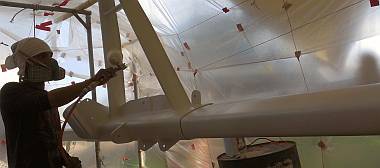 Baw finally turning our forebeam white again! |
OK. So by now an hour and a half had passed since the second green primer spray, and Baw and Heru were already gloved up in blue Nitrile gloves to gently sand the new coating and wipe it with alcohol. At 4:45 we fired up the compressor once again, and Baw, armed with his 1.8mm gun again, began to give the forebeam a white coating. He went through more than a liter and a half of Interseal 670 (thinned a bit for the spray gun) and got on about 4 layers in an hour. Lek and Heru stayed overtime to help out, mixing the primer and filling the pot and tending to the compressor. So, after thinking the day was a big waste in the painting department, we ended up with a smooth, shiny, opaque white forebeam. This primer can be sanded as though it's a "high build", meaning it can be used to hide indents and dips and irregularities in the aluminum surface. Baw came out of the tent iced in white, but happy. Next step: sand the white primer and spray with Interthane 990 polyurethane top coat.
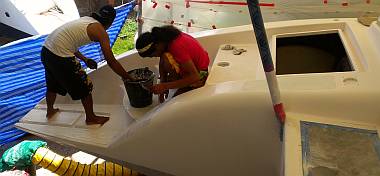 Akoosh and Chambron working on the port sugar-scoop |
The jury's still out on whether we use OceanMaster Etch Primer on the other spars, or switch to AwlGrip's Max Cor. Given the poor coverage of OceanMaster (compared to its advertised coverage) the price is very favorable for the (nominally) much more expensive AwlGrip. Of course, if they lie about their coverage as well... Stay tuned.
Saturday, October 12:
A good end to a good week, although nothing too earth‑shattering happened today. What did
shatter the earth, though, were the thousands of firecrackers set off, right on our road to the yard.
A small Vegetarian Festival Procession was due to come along about 10, and by 9 the streets
were already lined with people in white, the sidewalk altars laden with fresh fruit, tea,
flowers and incense. And tens of thousands of firecrackers. They don't just light off a pack.
They take several strings of 1,000 firecrackers, hold them up with long bamboo poles, and light several of
them off as certain parts of the procession pass (after which the road is red with firecracker paper).
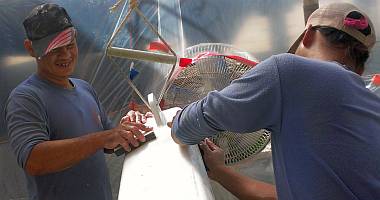 Pla and Heru wet-sanding the forebeam paint mid-coat smooth |
It was a hot, sunny day and poor Baw, Heru and Pla spent most of the day inside the "greenhouse" spray tent with the forebeam. They wanted to sand it smooth and put filler on low spots so that it will look awesomely wonderful when finally sprayed with a top coat of linear polyurethane. It was probably more TLC than it needed, but given all the disappointments with the spars it will be nice to see them well taken care of.
In anticipation of spraying International Interthane 990 on the forebeam, Sue went out in search of a paint shop that would tint the International paint to match our warmer "Ocelot white" gelcoat. No luck. The shops basically only color their own paints (Jotun, Berger, whatever) and there's no official International store. But nobody here uses Jotun as a top‑coat - most folks we've talked to recommend International's polyurethane and just use it white, which is what we've decided to do for our spars.
|
Sue removing old silicone from the window frame |
Jon sanded the rudders some more, repairing their trailing edges and getting one ready to replace the glass on the rudder top. Can't wait to see them in the boat.
Jon also consulted with Houa about removing the 2 badly acetone‑damaged windows on the port side of the salon. Months ago, someone spilled some acetone onto the acrylic and it sat there, trapped under the vinyl masking, melting parts of the acrylic window. Baw claims he can polish it out, but even if he could get rid of the worst damage we're pretty sure we'd still have a wavy window, which is not what we want to look out of from our salon. With a sharp razor cutter and some strength, Jon was able to slice through the black silicone that held that window in place and waterproof for the last 18 years.
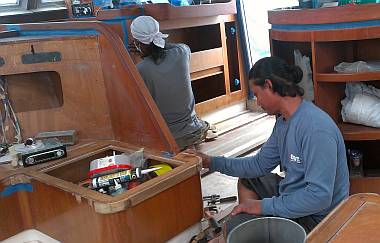 Houa works on the teak trim while Lek epoxies some bare wood |
To remove the silicone sealant, Houa supplied a couple nifty bent metal tools that he uses for removing Sika calking from teak grooves. They work wonders for scraping out the old silicone around the aluminum window frame. Sue has more patience for silicone and its devious properties, so she took over from Jon and enjoyed sitting on the new deck, with her feet in the salon window. Still a lot of work to do, but it will be worth it, and late in the day Jon found a stiff fiber wheel we can use in the drill to remove the silicone without damaging the aluminum frame. We may let Baw take a swing at polishing up the tiny scratches in some of the other windows, but at least the 2 damaged ones on port side will be replaced. Now to find some matching lightly tinted acrylic in the right thickness...
Houa put in more of the teak salon seat trim. He made a nice diagonal scarf on the very aft seats. He also got a long piece of teak laminated and planed to size so that it's the right width to match the other seat trim, saving us from having to buy more teak.
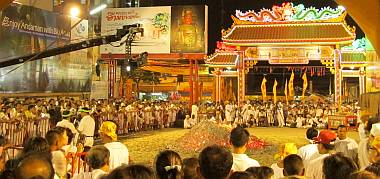 Crowds at the temple around the huge pile of glowing coals |
The sugar‑scoop teams will probably get new work on Monday, as the guys on portside got it sanded all the way up to 2,000 grit! Next step: polishing with the polisher and big buffing wheel. Starboard is just a few hours behind.
Tomorrow is the last day of the Phuket Vegetarian Festival so we scootered to Phuket town at 7pm to see the fire walking at the Bang Neow Chinese Temple. The whole street was closed to traffic and lined with food stalls. The temple dragons were lit with LED lights, and a massive pile of glowing coals shimmered in the center of the courtyard, but we were certainly not alone. We found standing room about 8 people back from the enclosure (being tall helps!) but close enough to still feel the heat of the fire. The ritual began with some wild dancing and waving of arms. Then the participants, all in a trance and many shirtless and fully tattooed, began the fire walking. More of a run, really, but some slowed down or did little dance steps. Crossing the 20' (6m) bed of glowing embers took 4‑5 steps for each man. Several times a team of fire‑tenders would beat the coals with a long flexible pole, presumably to knock off the ash, then the men would start across again. We didn't count but there seemed to be at least 100 fire‑walkers, all men.
Afterwards we wandered the closed‑off street, enjoying some street food and all the bustle and holiday feel of the townspeople. We called it an early night as we want to be back in town at 7am to see the last of the big processions.
Sunday, October 13: Vegetarian Festival
WARNING - VERY GRAPHIC CONTENT BELOW
No rest for the weary. On our only nominal "day off" we were up and out, riding Scooter to
Phuket town before 7. An early morning shower had cooled the air, making it a lovely, fragrant
time to be out. Activities at the Sui Boon Tong Chinese Temple in Phuket were well underway
when we got there. Inside the temple, breakfast "bow" (steamed dumplings) were being handed
out and throngs of people (all dressed in white) were praying and making offerings of incense and
fruit to the Chinese gods.
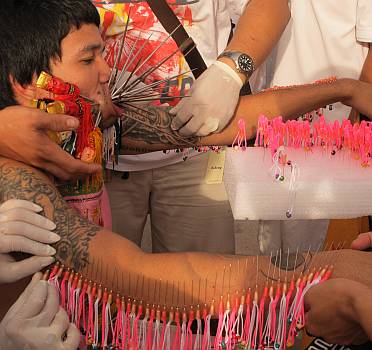 Extreme cases add decorated needles along their arms |
 Very few women decide to get themselves pierced |
The main feature of each procession are the ma song (literally translated as entranced horses), men (and a few women) who have been chosen to embody the spirits of the gods. As we arrived dozens of ma song were going into trances, sometimes yelling, screaming, gyrating and/or shaking, then pounding their hands on the altars before settling down to be dressed in ritual robes and maybe to be pierced. The piercing took place on the balcony of the temple, and we were not only allowed to watch, but actively encouraged. With a bevy of attendants surrounding them, the ma song are pierced with everything from decorated stainless steel needles in the arms, forehead, and back, to swords or elaborate spikes through their cheeks or tongues.
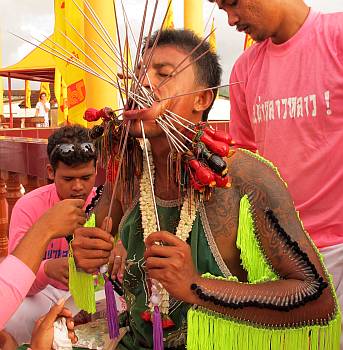 A mouthful and 3 rows of decorated arm needles |
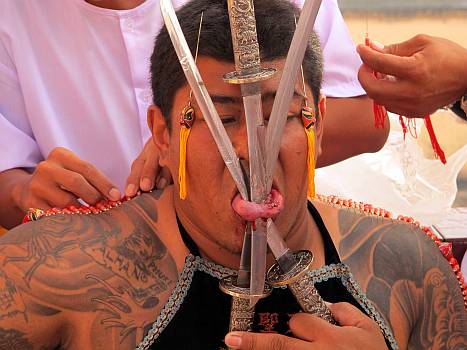 Very few people want tongue-piercings - usually only cheek piercings |
Once pierced and robed, the ma song and their attendants join the procession of palanquins, floats, and music trucks which wind for many kilometers through the town. Families set up table altars with fruits, tea, flowers and incense, ready and hoping to receive the blessings of the ma song as they pass by. Unlike other processions, the Vegetarian Festival procession is a free‑for‑all in that anyone can walk with the procession, moving in and out of the crowds and the ma song. The attendants play the important roles of wiping sweat and blood from the ma song and guarding them from being accidently bumped by others.
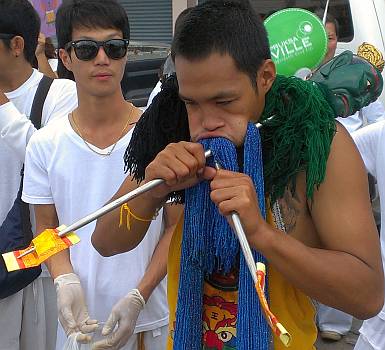 We hadn't seen strings of beads pushed through cheeks before |
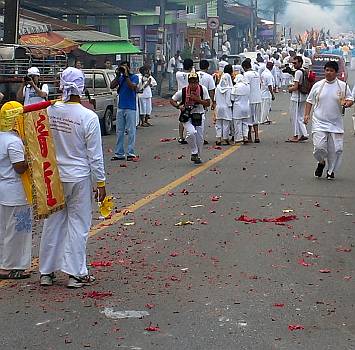 Firecracker smoke ahead & firecracker litter on the street |
This is our third Vegetarian Festival (which is fairly specific to Phuket) and this was our first time at the Sui Boon Tong Temple. In previous years the ma song of the Jui Tui Temple were pierced with extravagant and sometimes almost comically immense items: a beach umbrella, saxophone, guns, barbed wire, 10' long spikes, etc. At this smaller and less known temple today, the ma song were pierced with more traditional items such as swords, knives, and stainless steel needles or skewers, sometimes with small effigy heads of gods or evil spirits. We watched some of the piercings (not for weak stomachs) then joined the procession for 2½ hours of walking through town.
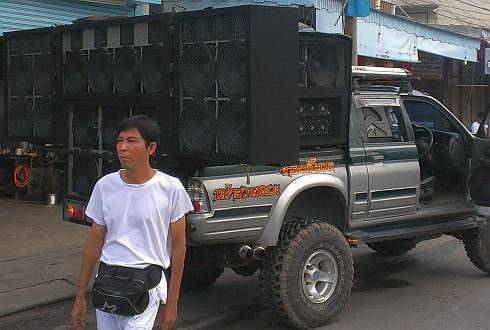 Sound truck - they played nice music, but WAY too loud to be very close to |
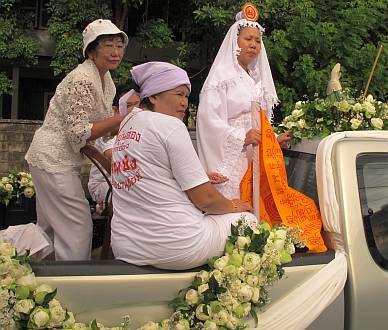 Woman ma song on a decorated float-truck |
Besides the ma song and their attendants, the procession also included sound trucks (pickup trucks/utes/bakkies with HUGE speaker systems in back, pumping out many thousands of watts of music), floats (decorated pickup trucks with beautifully dressed women ma song standing up in back, handing out candies or other small trinkets as blessings), and effigies of gods carried on palanquins by multiple men. The gods were targets of huge firecracker onslaughts, with packs of firecrackers thrown at them (and their bearers) constantly from the sides of the road, or lowered onto them by bamboo poles. Their attendants also carried towels, to blow the smoke away. Bearers and attendants wore ear plugs and sometimes eye protectors, but like the ma song, they were usually barefoot. Sometimes we were surrounded by music trucks and/or firecracker attracting palanquins, and the noise of the firecrackers and blaring theme songs echoed from the buildings with painful intensity. Other times the noise fell to the background and we walked amidst the ma song and their brightly clad attendants.
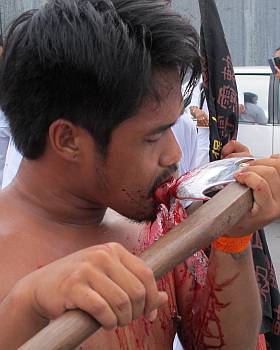 Tongue-cutters periodically swipe their blades |
 We hadn't seen head-cutters in our previous Veg Festivals |
Some of the most interesting and new (to us) ma song were the tongue‑ and forehead‑cutting men. They carried swords, knives or hatchets to inflict bloody cuts on their tongues and/or faces, letting the blood fall to their faces and chests. Many also had bloody whip‑marks on their backs (probably self‑inflicted). Again, not for the queasy, but quite a spectacle! This is all taken very seriously by the attendees and the observers on the sides of the road. They pray that the entranced horses will remove any bad luck and bad spirits, and grant them good health in the year to come.
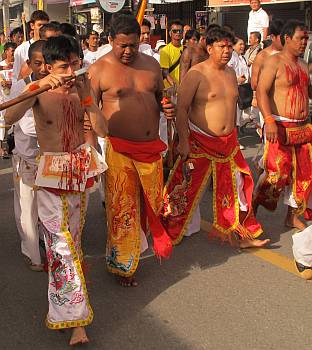 Tongue-cutters walking in the procession |
 Ma song giving blessings at a road-side altar - note firecrackers |
Thai Refit:
Ocelot Pages:
Top Level: Home | Destinations | Cruising Info | Underwater | Boat Guests | Ocelot | Sue | Jon | Amanda | Chris | Site Map | Make a Comment
|
If our information is useful, you can help by making a donation |
Copyright © 2000‑ Contact: Jon and Sue Hacking -- HackingFamily.com, svOcelot.com. All rights reserved.